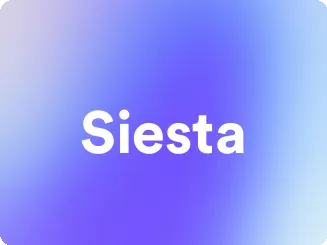The Art of Siesta: Embracing Productive Rest
This guide will walk you through the essential elements of using siesta - the productivity method to keep your team productive and engaged.
Try Lark for Free
In a fast-paced world, the concept of siesta holds a special allure. Originating from the Latin word "hora sexta," which translates to the "sixth hour" from dawn, siesta traditionally refers to a short midday nap taken to escape the scorching heat of the sun. However, its significance goes beyond mere relaxation—it also encompasses productivity and mental well-being. This article dives into the multifaceted realm of siesta, exploring its origins, its relevance in today's society, the associated pros and cons, and actionable tips for making the most of this rejuvenating practice.
What is Siesta in the Context of Productivity?
Siesta refers to a short period of rest, typically taken after the midday meal. It is a time-honored tradition in numerous cultures, promoting a brief and rejuvenating break during the day's activities. In the context of productivity, siesta serves as an invaluable tool for recharging one's energy and enhancing cognitive functions. By allowing the mind to momentarily detach from the demands of the day, individuals can experience increased alertness, creativity, and overall improved performance.
What is the Origin of Siesta?
The practice of siesta finds its roots in ancient civilizations, where communities adapted their daily routines to accommodate the harsh climatic conditions. In countries with predominantly warm climates, such as Spain, Greece, and Mexico, the tradition of a midday siesta emerged as a means to seek respite from the intense midday heat. Over time, the siesta became deeply intertwined with cultural norms and work-life balance, shaping the daily rhythm of entire societies.
Use Lark to unleash your team productivity.
Who is Siesta For?
Siesta transcends societal boundaries and is beneficial for individuals across various walks of life. It is particularly advantageous for:
- Professionals: Those seeking to enhance their productivity and avoid midday burnout.
- Students: Individuals aiming to optimize their learning potential and consolidate information.
- Elderly Individuals: The elderly, who may benefit from a brief rest to maintain energy levels throughout the day.
- Parents: Parents looking to carve out a moment of peace amidst their busy schedules.
What are the Pros and Cons of Siesta?
Pros:
Siesta offers a myriad of benefits, including:
- Enhanced Productivity: By recharging the mind, siesta can lead to improved focus, creativity, and efficiency.
- Mental Well-being: Taking a siesta can alleviate stress, enhance mood and contribute to overall mental well-being.
- Improved Physical Health: Studies have shown that short periods of rest can positively impact cardiovascular health and regulate blood pressure.
Cons:
While the advantages of siesta are substantial, potential drawbacks include:
- Disruption of Routine: Incorporating a midday nap may disrupt established work or study routines.
- Negative Stereotypes: In some cultures, siesta is associated with lethargy and unproductivity, leading to misconceptions in professional settings.
- Sleep Inertia: Awakening from a nap may lead to a brief period of grogginess, albeit this typically dissipates quickly.
Learn more about Lark x Productivity
How to Get Started with Siesta
Incorporating siesta into one's daily routine requires a thoughtful approach. To transition into this practice seamlessly, consider the following steps:
- Identify an Optimal Time: Determine the most suitable time for your siesta, ideally within the early afternoon and lasting no longer than 20-30 minutes.
- Designate a Restful Space: Create a tranquil environment conducive to relaxation, free from distractions and excessive noise.
- Establish a Ritual: Develop a pre-siesta routine, such as drinking herbal tea or practicing deep breathing exercises, signaling the body to wind down.
Use Lark to unleash your team productivity.
Actionable Tips for Siesta
To optimize the benefits of siesta, consider these practical recommendations:
- Duration Matters: Keep your siesta brief, aiming for approximately 20 minutes to avoid entering deep sleep and experiencing sleep inertia.
- Consistency is Key: Strive to maintain a regular siesta schedule, as predictable timing reinforces the body's natural rhythms.
- Avoid Stimulants: Refrain from consuming caffeine before your siesta, as it can impede the ability to fall asleep and undermine the restfulness of the period.
Do's and Dont's
The table below outlines essential do's and don'ts to consider when embracing the practice of siesta:
| Do's | Dont's |
|---|---|
| Create a soothing ambience | Consume heavy meals before siesta |
| Set a timer to avoid oversleeping | Engage in mentally demanding tasks post-siesta |
| Practice deep breathing techniques | Depend on siesta as a remedy for chronic sleep deprivation |
Conclusion
In conclusion, siesta encompasses far more than a brief afternoon nap; it represents a revered tradition deeply interwoven with cultural, productivity, and well-being implications. By understanding its origins, benefits, and practical application, individuals can harness the power of siesta to achieve heightened productivity and holistic well-being.
Use Lark to unleash your team productivity.
